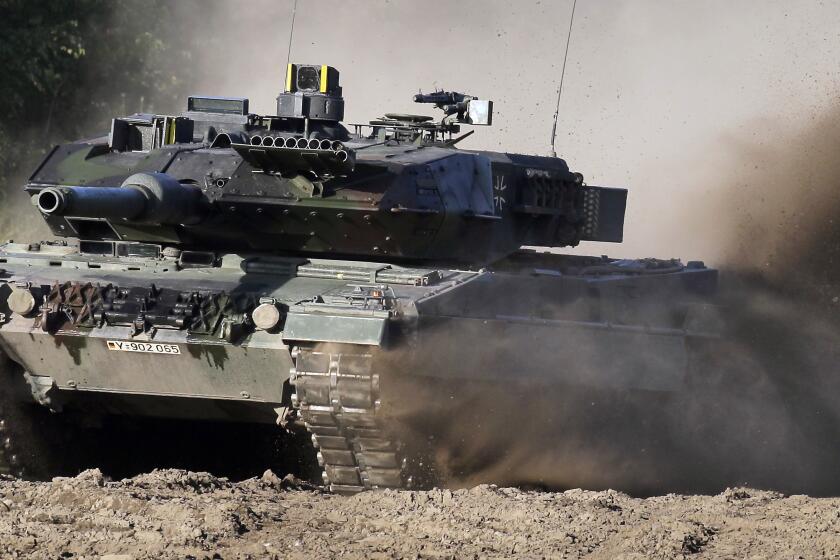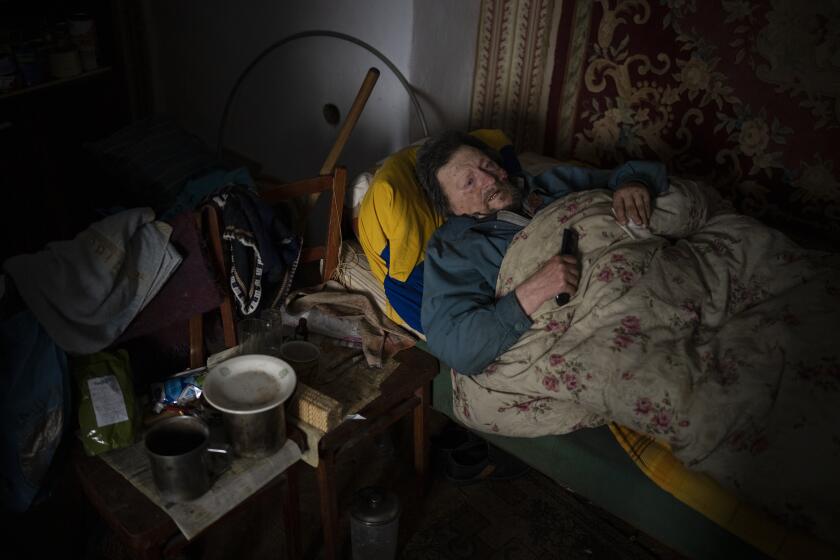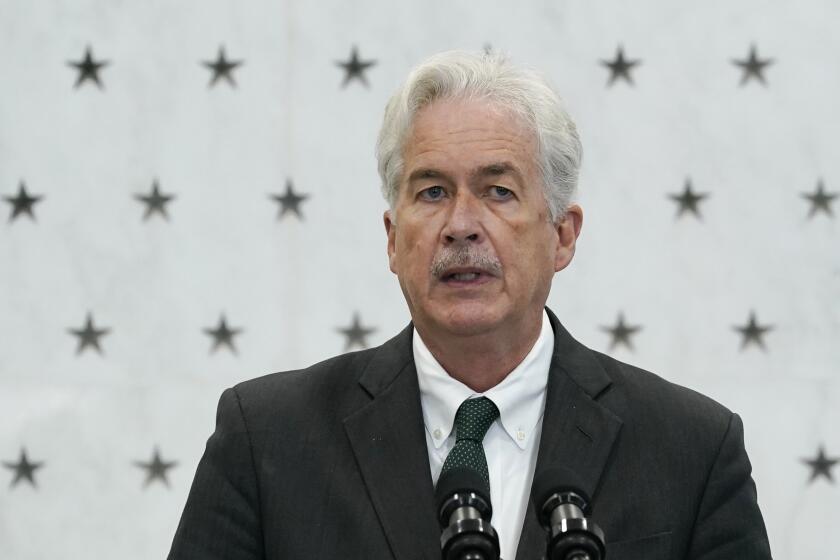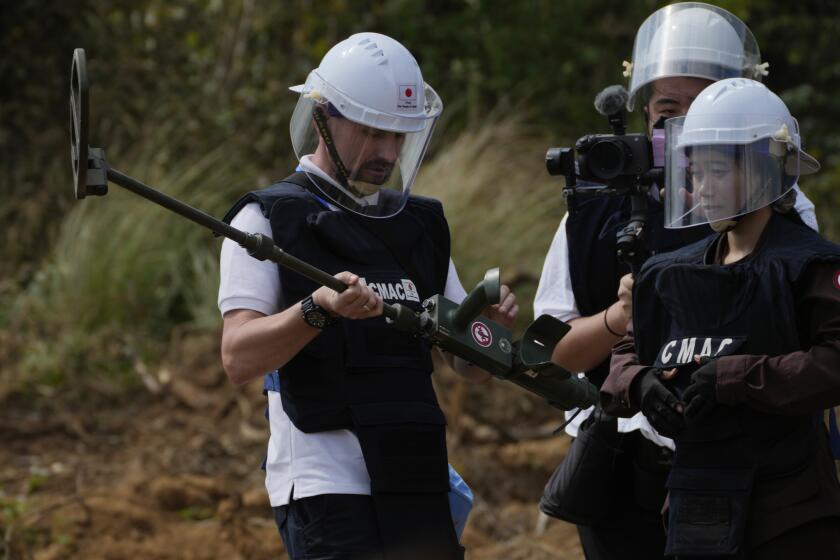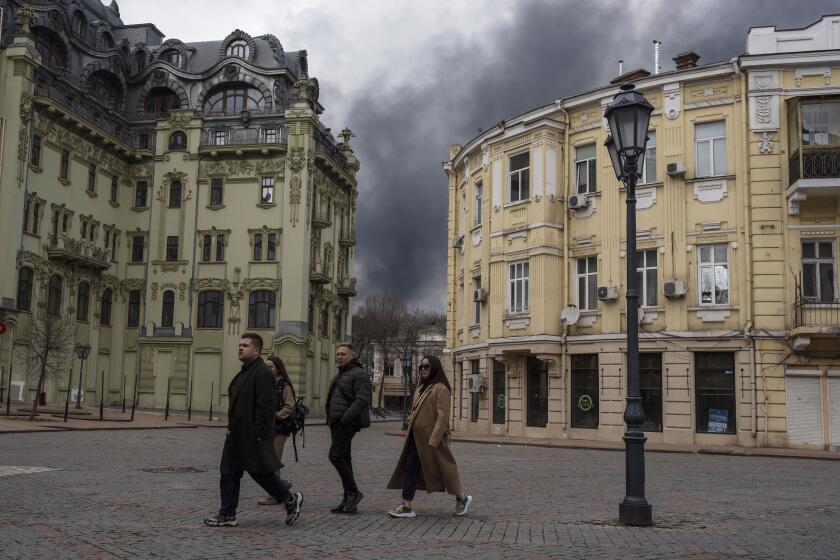With tanks on the way, talk of sending Ukraine warplanes could strain Western unity anew

- Share via
KYIV, Ukraine — Ukraine won support Tuesday from Baltic nations and Poland in its quest to obtain Western fighter jets, but there were no signs that larger nations such as the U.S. and Britain have changed their stance of refusing to provide the warplanes to Kyiv after almost a year of its battle against Russia’s invading forces.
“Ukraine needs fighter jets ... missiles, tanks. We need to act,” Estonian Foreign Minister Urmas Reinsalu said in the Latvian capital, Riga, at a news conference with his Baltic and Polish colleagues. Those countries, which lie on the North Atlantic Treaty Organization’s eastern flank, feel especially threatened by Russia and have been the leading advocates for providing military aid.
Ukrainian Defense Minister Oleksii Reznikov held talks with his French counterpart, saying they did not discuss specific fighter jets but did talk about aviation “platforms” to help Ukraine’s ground-to-air defense.
“I don’t know how quick it will be, this response from Western allies” to Kyiv’s requests for fighter jets, Reznikov said. “I’m optimistic, and I think it will be as soon as possible.”
He also listed weapons Ukraine has sought in the last year, starting with Stinger missiles, and said the first response was always: “Impossible.’’ Eventually, though, “it became possible,” Reznikov said.
French Defense Minister Sebastien Lecornu, speaking alongside Reznikov, said there were “no taboos” on sending fighter jets. He also confirmed that France was sending 12 more Caesar cannons in the coming weeks.
Germany may soon approve deliveries of high-tech Leopard 2 tanks that Ukraine and others hope will boost Kyiv’s fight against Russian invaders.
French President Emmanuel Macron said Monday that France doesn’t exclude sending fighter jets to Ukraine, but he laid out multiple conditions before such a step could be taken, including not leading to an escalation of tensions or using the aircraft “to touch Russian soil,” and not resulting in a weakening of “the capacities of the French army.”
Reznikov’s trip came a week after Western nations pledged to send Kyiv sophisticated modern tanks.
Several Western leaders have expressed concern that providing warplanes could escalate the conflict and draw them deeper into the war.
The British government, which has been one of Kyiv’s staunchest diplomatic supporters and military suppliers, said that sending it fighter jets is “not practical.”
A top aide to Ukraine’s president says Kyiv and its Western allies are engaged in talks on equipping the country with long-range missiles and military aircraft.
Prime Minister Rishi Sunak’s spokesman, Max Blain, said that Britain’s “Typhoon and F-35 fighter jets are extremely sophisticated and take months to learn how to fly. Given that, we believe it is not practical to send those jets into Ukraine.”
Blain did not say that Britain was opposed to other countries sending planes.
Asked by a reporter Monday if his administration was considering sending F-16 fighter jets to Ukraine, President Biden said no.
On Tuesday, Reznikov was asked if Biden’s ‘’no” to F-16s was the final word.
“All types of help first passed through the ‘no’ stage,” he said. “Which only means ‘no’ at today’s given moment. The second stage is, ‘Let’s talk and study technical possibilities.’ The third stage is, ‘Let’s get your personnel trained.’ And the fourth stage is the transfer [of equipment].”
Reznikov said Ukraine went through those stages before it got the High Mobility Artillery Rocket Systems, or HIMARS, the Bradley armored vehicles and 155-millimeter artillery.
“Remember the story of the German Leopards — the answer was also ‘no,’” he added. “And now we have a tank coalition. Therefore I believe an airplane coalition is within reach. But first there should always be a leader. And that’s why I’m here.”
Kyiv officials have repeatedly urged allies to send jets, saying they are essential to challenge Russia’s air superiority and to ensure the success of future counteroffensives that could be spearheaded by tanks recently promised by Western countries.
CIA Director William Burns visited Kyiv last week to meet with Ukrainian President Volodymyr Zelensky.
Ukraine’s allies also have ruled out providing Kyiv with long-range missiles able to hit Russian territory, citing potential escalation.
After months of haggling, Ukrainian authorities last week persuaded Western allies to send the tanks. That decision came despite the hesitation and caution of some NATO members, including the United States and Germany.
German Chancellor Olaf Scholz appeared to balk at the prospect of providing fighter jets, suggesting Sunday that the reason for the entire discussion might be down to “domestic political motives” in some countries.
Dutch Prime Minister Mark Rutte said Monday that there are “no taboos” in the efforts to help Ukraine. But he added that sending jets “would be a very big next step.”
Breaking News
Get breaking news, investigations, analysis and more signature journalism from the Los Angeles Times in your inbox.
You may occasionally receive promotional content from the Los Angeles Times.
Asked Tuesday about the supplies of Western weapons to Ukraine, Russian Foreign Minister Sergei Lavrov repeated the Kremlin’s view that “NATO long has been directly involved in a hybrid war against Russia.”
Following talks in Moscow with Egyptian Foreign Minister Sameh Shoukry, he said the Russian military will “take all the necessary measures to derail the fulfillment of Western plans.”
He said Shoukry conveyed a message from U.S. Secretary of State Antony J. Blinken about Ukraine, which repeated Washington’s previous calls for Russia to withdraw.
Lavrov said: “Russia is ready to hear any serious — I want to underline this word — proposal aimed at comprehensive settlement of the current situation.”
Cambodian experts, whose country has the dubious distinction of being one of the world’s most contaminated by land mines, teach Ukrainians how to clear mines.
Both Ukraine and Russia are believed to be building up their arsenals for an expected offensive in coming months. The war has been largely deadlocked on the battlefield during the winter.
Asked about the call for Western countries to provide Ukraine with fighter jets and long-range missiles, Kremlin spokesman Dmitry Peskov said the comments “reflected an aggressive approach taken by the Baltic nations and Poland, who are ready to do everything to provoke further escalation without thinking about consequences.”
The president of NATO member Croatia, meanwhile, criticized Western nations for supplying Ukraine with heavy tanks and other weapons. President Zoran Milanovic argued that those arms deliveries would only prolong the war.
The United Nations’ cultural agency has added the historic center of Ukraine’s Black Sea port city of Odesa to the list of endangered World Heritage sites.
Earlier in the conflict, discussions focused on the possibility of providing Kyiv with Soviet-made MiG-29 fighter jets that Ukrainian pilots are familiar with. In March, the Pentagon rejected Poland’s proposal to transfer its MiG-29 fighter jets to Kyiv through a U.S. base in Germany, citing a high risk of triggering a Russia-NATO escalation.
Ukraine inherited a significant fleet of Soviet-made warplanes, including Su-27 and MiG-29 fighter jets and Su-25 ground attack aircraft.
Switching to Western aircraft would require Ukrainian crews to undergo long training and would also raise logistical challenges linked to their maintenance and repair.
Russia methodically targeted Ukrainian air bases and air-defense batteries in the opening stage of the conflict, but Ukraine has been smart about relocating its warplanes and concealing air-defense assets, resulting in Russia’s failure to gain full control of the skies.
After suffering heavy losses early during the conflict, the Russian air force has avoided venturing deep into Ukraine’s airspace and mostly focused on close support missions along the front line.
More to Read
Sign up for Essential California
The most important California stories and recommendations in your inbox every morning.
You may occasionally receive promotional content from the Los Angeles Times.
